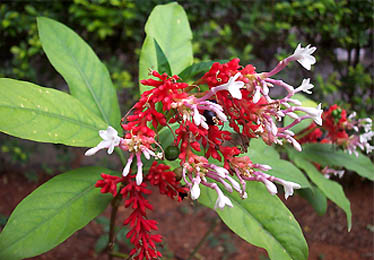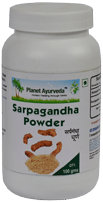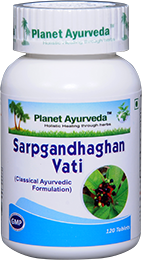Sarpagandha (Rauwolfia serpentina) – Uses, Properties, Benefits, Side effects & Dosage

Sarpagandha Plant
Sarpagandha Plant is an evergreen, erect glabrous perennial shrub that normally grows up to a height of 60 cm. Sarpagandha scientific name is Rauwolfia Serpentina
Roots of this herb are tuberous with a cork of a pale brown color.
Leaves of this plant are generally found in whorls of three, and are bright green colored above and pale green colored below. The base of the leaves is slender and tapering in nature. Petioles of this plant are long.
The flowers are white in color, sometimes violet in color and contains nectar at the deep of the corolla tubes. Peduncles are long enough while the pedicles are stout. The calyx is bright red in color. Corolla is usually longer than the calyx. Drupes of this plant are slightly connate, ovoid and are of purplish black color. The flowering period of this plant is March to May in India.
Its fruit are oval fleshy and tiny which turn shiny purple-black on ripening.
General Description
Rauwolfia serpentina has been known for its medicinal value. It is one of the finest remedy that is widely used for high blood pressure and also as sedative and tranquillizing agent.
Rauwolfia serpentina comprises of many bioactive chemicals with more than 50 different alkaloids. Out of 50 alkaloids, main alkaloids present are ajmaline, ajmalicine, indobine, indobinine, ajmalimine, serpentine, serpentinine, deserpidine, reserpinine, reserpiline, rescinnamine, yohimbine and yohimbinine. Reserpine is quiet useful alkaloid of this plant. About 90 percent of these alkaloids are found in the tuberous roots of this plant.
Rauwolfia Serpentina Classification
- Kingdom: Plantae
- Division: Magnoliophyta
- Class: Magnoliopsida
- Order: Gentianales
- Family: Apocynaceae
- Genus: Rauwolfia
- Species: Serpentina
Habitat
This plant is found in India, Pakistan, Sri Lanka and Burma as well as in Thailand. In India, it is distributed in the sub-Himalayan tract from Punjab to Nepal, Sikkim and Bhutan. It is also found in the lower hills of Gangetic plains, Andaman, Eastern and Western Ghats. In India, it is found in moist deciduous forest and shady areas at a height of 4000 feet above the sea level. This plant is never growing in bulk at a single place. In short, it is widely cultivated in many parts of the India.
Sarpagandha Names
- English Name – Sepentina root, Indian snakeroot, Rauwolfia root, serpentine root
- Hindi Name – Chota chand, Hrakai chand, Nayi, Nakulikand, Nkulkanda, Rasnabhed
- Kannada Name – Sarpagandhi, Chandrika, Sutranabhi, Patala garuda.
- Bihari Name – Chandmarua, Dhanmarua, Dhanbarua, Dhavalbarua, Sanachando, Isargaj
- Telugu name – Dumparasna, Patala Garuda, Patalagani, Patalagaruda, Patalagandhi, Padagpuchahv
- Bengali Name – Chandar, Nakuli, Chotachand, Chandra Nolbel ,Gandrasana, Sugandhanakuli
- Marathi Name – Adkayi, Adakayi, Chotachand, Harki, Sapasanda,
- Gujarati Name – Amelpodi, Amelpadi, Norbal
- Tamil Name – Carpakanta, Covanna Milpadi, Sivan amalpodi, Savannamibori, Covanna milpori, Sarppaganti, Civan amal podi.
- Malayalam Name – Amalpori, Chivan amalpodi, Civan amalpadi Chivan Avalpori, Tullunni, Chuvanna avilpori, Chuvanna amalpari
Ayurvedic Properties of Sarpagandha
| Hindi / Sanskrit | English | ||
| Rasa | Tikta | Taste | Bitter |
| Guna | Rooksha | Physical Property | Dry |
| Virya | Ushna | Potency | Hot |
| Vipaka | Katu | Metabolic Property (After Digestion) | Pungent |
Effects on Doshas
It balances Vata and Kapha dosha.
Classical Categorization
| Sushrut Samhita | Dhanwantari Nighantu | Priynighantu | Sodhala nighantu |
|
Aparajita Gana (Uttara Tantra) |
Karveeradi varga |
Shatpuchpadi varga |
Guduchyadi varga, Kerveeradi varga |
Ancient Verse about Rauwolfia serpentina

The Bhavprakash nighantu edition of 1998: verse 165-166 page no- 83-86
The names and properties of Sarpagandha are Nakulik, Sursa, Nagsugandha, Gandhanakuli, Nakuleshta, Bhujdrakshi, Sarpadhri and Vishnashani. It is astringent, bitter, pungent in taste and hot in potency. Sarpagandha detoxifies poison of snakes, spiders, scorpios and mouse. It also manages fever, wound and worm infestation.
References
The Bhavprakash nighantu with elaborated Hindi commentary by Padmashri prof. K.C. Chunekar, edited by Dr. G.S. Pandey: edition of 1998: verse 165-166 page no- 83-86.
Health Benefits of Rauwolfia serpentina
- Sarpagandha has property to balance Vata and pitta Dosha in the body.
- This herb has ability to reduce the heart rate and dilates blood vessels with lowering of blood pressure. (1, 2)
- Very useful treatment in high blood sugar (Diabetes).
- It is also a suitable remedy for insomnia (1, 2), hysteria and hypertensive patients.
- For relieving hysteria take one gram powder of Sarpagandha root, thrice daily with milk every day.
- This herb has good use in case of cataract.
- Effective in plague and fever.
- Sarpagandha is useful remedy in Schizophrenia. (1, 2)
- It is often used as sedative and tranquilizer in different countries.
- Rauwolfia serpentina has found to be useful in treatment of anxiety (3), psychosis (2) and epilepsy. (1, 2)
- It is also quiet efficient herb for colic and cholera.
- The root of this plant is given in difficult childbirth.
- It is useful in uterine contraction.
- This herb is used in several part of the world for the treatment of snake (cobra), scorpion, reptile bite and stings of any poisonous insects.
- Since ages its extract is being used against dysentery.
- It has been used as a remedy for hypochondria, mental disorders and a certain form of insanity. The herb is as well-known medicine for the mentally upset people.
- Rauwolfia serpentina has also been used in the treatment of intractable skin disorder as in conditions like (psoriasis, excessive sweating and itching).
- It is useful in irregular heart beat in old age.
- Sarpagandha has ability to treat goiter.
- This herb is also beneficial in some of gynecological problems like frigidity. Sarpagandha is effectively used in other conditions like rheumatism, edema and intestinal diseases.
- The herb is good in constipation.
- It can regularizes menstruation when used as a mixture with ginger and black pepper
Part Used
Roots and Leaves of Sarpagandha are used.
Dosage
- Roots powder should be — (for normalizing high blood pressure) – 1-2 gm.
- For restlessness, anxiety and inducing sleep – 3-6 gm.
Sarpagandha Side Effects
Although Sarpagandha (Rauwolfia serpentina) herb has healthy effects but sometimes it may result in some side effects like:
- Swelling may occur in feet and lower legs
- Diarrhea (4), nausea (1) and vomiting (1, 4)
- Dizziness (4)
- Loss of appetite
Planet Ayurveda’s Products which Contain this Herb as an Ingredient
1. Sarpagandha Powder
Sarpagandha Powder is prepared from the herb sarpagandha plant and has various therapeutic properties. It has various medicinal properties like a sedative, carminative, hypotensive, antispasmodic and vasodilatory in nature. Its property of inducing sleep treats insomnia and is considered to be the best brain tonic also. It is also useful in mild to moderate hypertension and maintains the proper blood flow in the heart. In males, this powder is given to suppress the early ejaculation in males. Use of this powder also gives effective results in recurrent and chronic fever.
2. Sarpagandhaghan Vati
Sarpgandhaghan Vati is a classical Ayurvedic formulation which is prepared by Planet Ayurveda and has various medicinal uses. It comprises of carminative, sedative, anti-hypertensive and diuretic properties. In insomnia, it is given to provide a calmness to the brain and pacifies the vitiated vata dosha in the body. This Sarpagandha tablet is prepared from the herbs like sarpagandha, jatamansi, khurasani ajwain, and bhanga. It is mainly useful in conditions such as high blood pressure and increased pulse. According to Ayurveda, it pacifies the vata and kapha dosha in the body. Besides all of this, it is also helpful in various neurological conditions like stress, anxiety, depression etc. It flushes out the toxins from the body and also helps in blood purification.





